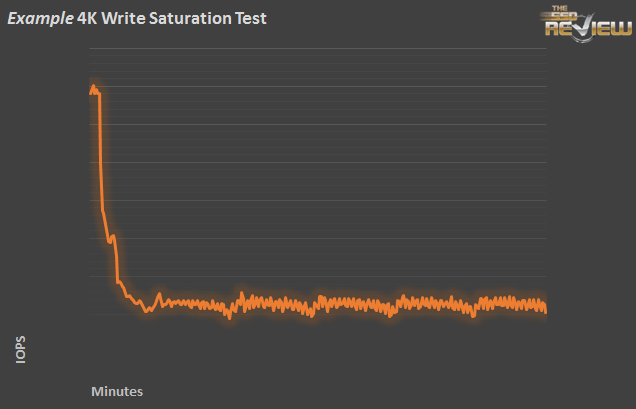WRITE TESTING
Because of the nature of solid state storage, once the drive gets filled, write speed takes a precipitous plunge. We can take a fresh drive and write 4K randoms to it for 300 minutes to see what happens.
Take the following chart for example:
This is just an example, but it’s what most every drive looks like. Once the drive runs out of free space, IOPS fall right off a cliff. It’s actually called the write cliff, and most drives exhibit the behavior. After a short time, the performance stops moving up or down more than one percent or so. That is steady state.
So now take a look at the Optimus’ test. Over five hours of QD 32 4K random write to the entire drive, nothing moves. It doesn’t get faster, or slower, it just remains at 43K IOPS for five straight hours. The test was run several times to verify, but remember the last chart on the previous page? Over 24 hours, each write at each block size looked almost exactly the same way. This particular run was chosen because of the slight dip after 31 minutes. Otherwise, it would have just been a flat line for 300 minutes.
We can lay the average latency over that five hours on the chart to show the relationship between IOPS and latency. As we saw in the basic performance testing, the average latency for a QD 32 4K random write was 741 microseconds. And in this chart, you can see that exactly, except for the slight dip at 32 minutes. Latency goes up there, IOPS go down. In any event, the Optimus just doesn’t move much over time, so performance after five seconds of operation and five weeks will look just about the same. Very cool.
The last write test is a 20 minute test immediately preceding the 4K write saturation testing. We look at the IOPS each second for a 70% read 30% write at a QD of 32. The SNIA IOPS testing above was the average IOPS over one minute tests. But on a second by second basis, performance fluctuates constantly. SLC drives tend to vary less from second to second, while MLC drives tend to fall all over the map. When consistent performance is important, taking a closer look can tell you how much the drive’s speed can jump around from second to second. The yellow line in the chart above is the average, and over 20 minutes the SMART averaged right at 60,000 IOPS. But occasionally, the drive might have only pushed 46K, or might have made it to 75K IOPS. Most of the points are clustered around the 60,000 mark. The Optimus does great here. It might not look like it, but you have to step up to some really expensive hardware to do much better here. In the realm of financial transactions, where every millionth of a second counts, this might not be the drive to choose, but it’s a great showing.
 The SSD Review The Worlds Dedicated SSD Education and Review Resource |
The SSD Review The Worlds Dedicated SSD Education and Review Resource | 


Firmware ultimately ends up being more important than the controller itself in many or most circumstances. Good FW can make a mediocre drive great, or a great drive a flaming dumpster fire.
That was beautiful, thank you for the insight. 🙂
The SSD market is RED HOT right now! Thanks Les for all the good stuff!
Reliability and predictable performance is very important. I wish consumer-oriented drives would be more like that. As a side note, what’s going on with the 12Gbps connection? Did you manage to sort it out? Perhaps it will work fine with Win7, WIn8 or Server 2012?
this is beautiful.. Wish my old kinston had the speed and reliability of this.